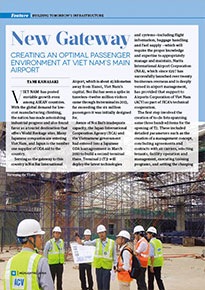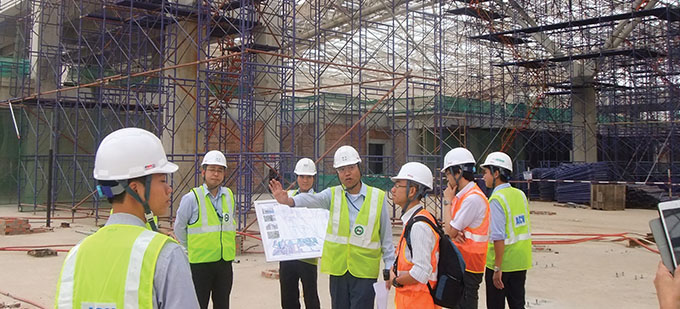Home > Highlighting JAPAN >Highlighting Japan December 2014>Building Tomorrow's Infrastructure
Highlighting JAPAN

Building Tomorrow's Infrastructure
New Gateway
Creating an optimal passenger environment
at Viet Nam’s main airport

Viet Nam has posted enviable growth even among ASEAN countries. With the global demand for low-cost manufacturing climbing, the nation has made astonishing industrial progress and also found favor as a tourist destination that offers World Heritage sites. Many Japanese companies are entering Viet Nam, and Japan is the number one supplier of ODA aid to the country.
Serving as the gateway to this country is Noi Bai International Airport, which is about 45 kilometres away from Hanoi, Viet Nam’s capital. Noi Bai has seen a spike in travelers—twelve million visitors came through its terminal in 2013, far exceeding the six million passengers it was initially designed for.
Aware of Noi Bai’s inadequate capacity, the Japan International Cooperation Agency (JICA) and the Vietnamese government had entered into a Japanese ODA loan agreement in March 2010 to build a second terminal there. Terminal 2 (T2) will deploy the latest technologies and systems—including flight information, baggage handling and fuel supply —which will require the proper knowledge and expertise to appropriately manage and maintain. Narita International Airport Corporation (NAA), which since 1997 has successfully launched over twenty businesses overseas and is deeply versed in airport management, has provided that support to Airports Corporation of Viet Nam (ACV) as part of JICA’s technical cooperation.
The first step involved the creation of to-do lists spanning some three hundred items for the opening of T2. These included detailed parameters such as the creation of a management concept, concluding agreements and contracts with air carriers, selecting tenants, facility operation and management, executing training programs, and setting the charging scheme for using airport facilities. Because the country, culture and laws differ from Japan’s own, the ACV team retooled NAA’s provisional list of considerations to create a version for Viet Nam. “We began by getting the local staff to understand why these items were important for airport operations,” says Yasuhiro Aso of NAA’s International Affairs and Overseas Business Office, Corporate Planning Division. “Therefore, the initial preparations were the biggest challenge.”
As T2 gears up for its opening, the most “Japanese” of NAA’s recommendations have been about customer satisfaction (CS) improvement. For example, claiming bags at an airport is generally viewed as a time-consuming and even stressful task. NAA proposed facility operation methods and maintenance management that would provide greater convenience for customers. NAA also promoted a plan for barrier-free facilities and terminal operations methods with high service levels that would benefit everyone, including the elderly and disabled. This wide-ranging CS improvement approach drew praise and agreement from the ACV, resulting in the creation of a CS working group led by Noi Bai International Airport executives and involving local staff. The ACV actively sought more input from its Japanese counterparts, and training in terminal operations was provided with particular emphasis on detailed maintenance management practices for the facilities at Narita International Airport. This favorable partnership unified the two airports, and T2 is slated to go live at the end of 2014.
The project also created an opportunity for NAA staff, including its younger team members, to absorb information about the construction of a large-scale airport, yielding major benefits for the company’s human resources. Seeing this favorable outcome, NAA’s Aso describes the company’s future outlook: “We want to engage our group companies and actively make inroads overseas—it would be great to participate in the management of an airport abroad.”
© 2009 Cabinet Office, Government of Japan






